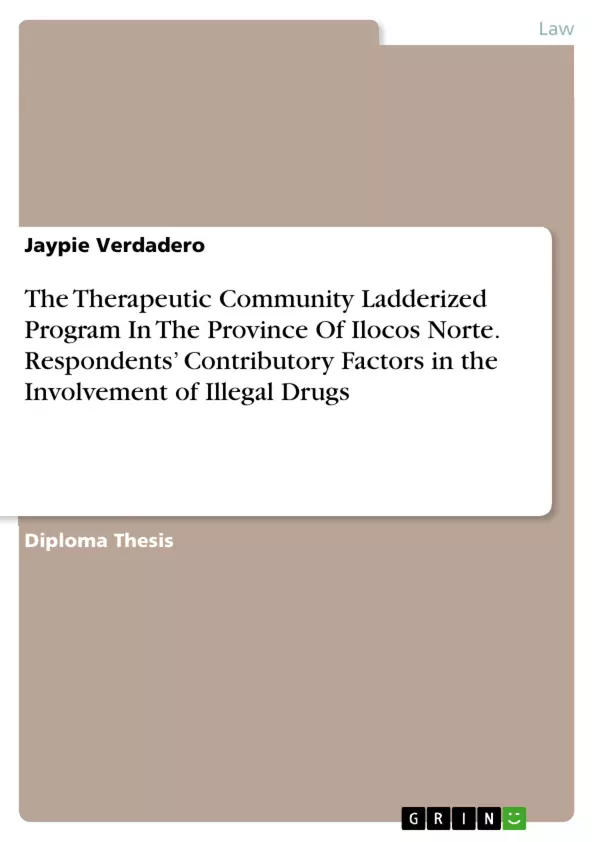This research study is all about Therapeutic Modality in the Philippines' Non-Institutional Corrections. The objective of the study was to determine respondents’ contributory factors in the involvement of illegal drugs and to assess the extent of implementation of Therapeutic Community Ladderized Program by the Ilocos Norte PPO and Laoag City PPO to probationers, as well as the problems they have encountered while undergoing said program. The study used the descriptive method of research and utilized questionnaire checklist and conducted informal interview to gather data. A total of 101 probationers undergoing the said program were taken as respondents.
Table of Contents
- CHAPTER I: THE PROBLEM
- CHAPTER II: PRESENTATION, ANALYSIS AND INTERPRETATION OF DATA
- CHAPTER III: SUMMARY, FINDINGS, CONCLUSIONS AND RECOMMENDATIONS
Objectives and Key Themes
The study aimed to identify the factors contributing to drug involvement among respondents and assess the implementation of the Therapeutic Community Ladderized Program (TCLP) for probationers in Ilocos Norte, Philippines. It also investigated problems encountered during the program.
- Factors contributing to drug involvement among probationers.
- Implementation of the TCLP in Ilocos Norte.
- Problems encountered by probationers in the TCLP.
- Effectiveness of the TCLP in addressing drug-related issues.
- Development of an action plan to enhance TCLP implementation.
Chapter Summaries
CHAPTER I: THE PROBLEM: This chapter introduces the concept of probation as a penalty alternative for less serious offenses. It discusses the historical context of probation laws in the Philippines, highlighting the evolution from the unconstitutional Act 4221 of 1937 to Presidential Decree 968 of 1976, which established the Probation Administration (later renamed Parole and Probation Administration). The chapter sets the stage for the study by outlining the significance of probation in reducing case backlogs and prison overcrowding while emphasizing the need for effective programs like the TCLP.
CHAPTER II: PRESENTATION, ANALYSIS AND INTERPRETATION OF DATA: This chapter presents the findings of the research, focusing on the demographic profile of the probationers participating in the TCLP in Ilocos Norte. It details the data gathered through questionnaires, checklists, and informal interviews from 101 probationers. The chapter analyzes the reported contributory factors to drug involvement, assessing their severity. It examines the extent of TCLP implementation, evaluating both relational/behavioral and cognitive/intellectual aspects of the program. Finally, the analysis covers the reported problems experienced by probationers while participating in the program, giving an overall picture of the program's effectiveness and challenges.
Keywords
Petitioners, Probationers, Clients, Therapeutic Community Ladderized Program (TCLP), Ilocos Norte, Drug Involvement, Probation, Parole and Probation Administration, Philippines.
Frequently Asked Questions: A Comprehensive Language Preview
What is the main topic of this study?
This study focuses on the Therapeutic Community Ladderized Program (TCLP) for probationers in Ilocos Norte, Philippines. It investigates the factors contributing to drug involvement among probationers, assesses the TCLP's implementation, and identifies problems encountered during the program.
What are the key objectives of the research?
The research aims to identify factors contributing to drug involvement among probationers, assess the TCLP's implementation, analyze problems encountered during the program, evaluate the TCLP's effectiveness in addressing drug-related issues, and develop an action plan to enhance TCLP implementation.
What data was used in the study?
Data was gathered from 101 probationers in Ilocos Norte through questionnaires, checklists, and informal interviews. The data includes demographic information and details about the probationers' experiences with drug involvement and the TCLP.
What are the key themes explored in the study?
Key themes include factors contributing to drug involvement among probationers, the implementation of the TCLP in Ilocos Norte, problems encountered by probationers in the TCLP, and the effectiveness of the TCLP in addressing drug-related issues. The study also explores the historical context of probation laws in the Philippines.
What is the structure of the document?
The document is structured into three chapters. Chapter I introduces the problem and the context of probation in the Philippines. Chapter II presents, analyzes, and interprets the data collected. Chapter III summarizes the findings, draws conclusions, and provides recommendations.
What are the key findings of the study (in general terms)?
The study analyzes the demographic profile of probationers, identifies factors contributing to their drug involvement, assesses the TCLP's implementation, and examines the problems encountered by probationers within the program. Detailed findings are presented in Chapter II. The overall effectiveness and challenges of the TCLP are discussed.
What are the key words associated with this research?
Key words include Petitioners, Probationers, Clients, Therapeutic Community Ladderized Program (TCLP), Ilocos Norte, Drug Involvement, Probation, Parole and Probation Administration, Philippines.
What is the historical context of probation in the Philippines mentioned in the study?
The study discusses the evolution of probation laws in the Philippines, from the unconstitutional Act 4221 of 1937 to Presidential Decree 968 of 1976, which established the Probation Administration (later renamed Parole and Probation Administration).
What methods were used to collect data?
The research utilized questionnaires, checklists, and informal interviews to gather data from the 101 probationers participating in the TCLP.
What is the purpose of the action plan mentioned in the objectives?
The action plan aims to improve and enhance the implementation of the TCLP based on the findings and conclusions of the study.
- Quote paper
- Jaypie Verdadero (Author), 2020, The Therapeutic Community Ladderized Program In The Province Of Ilocos Norte. Respondents’ Contributory Factors in the Involvement of Illegal Drugs, Munich, GRIN Verlag, https://www.grin.com/document/1245068



